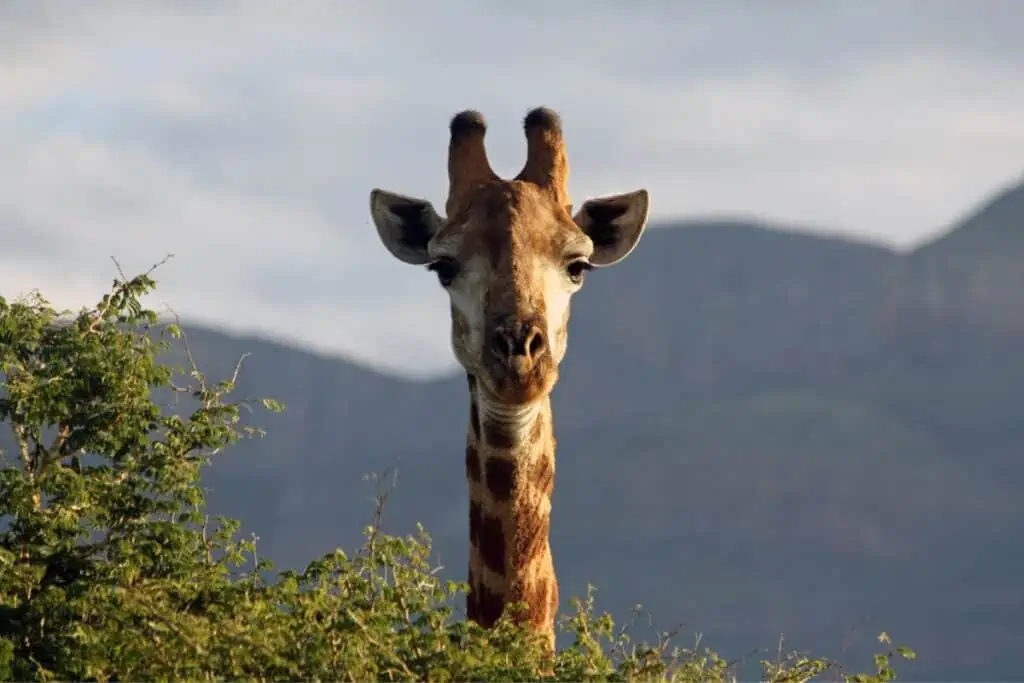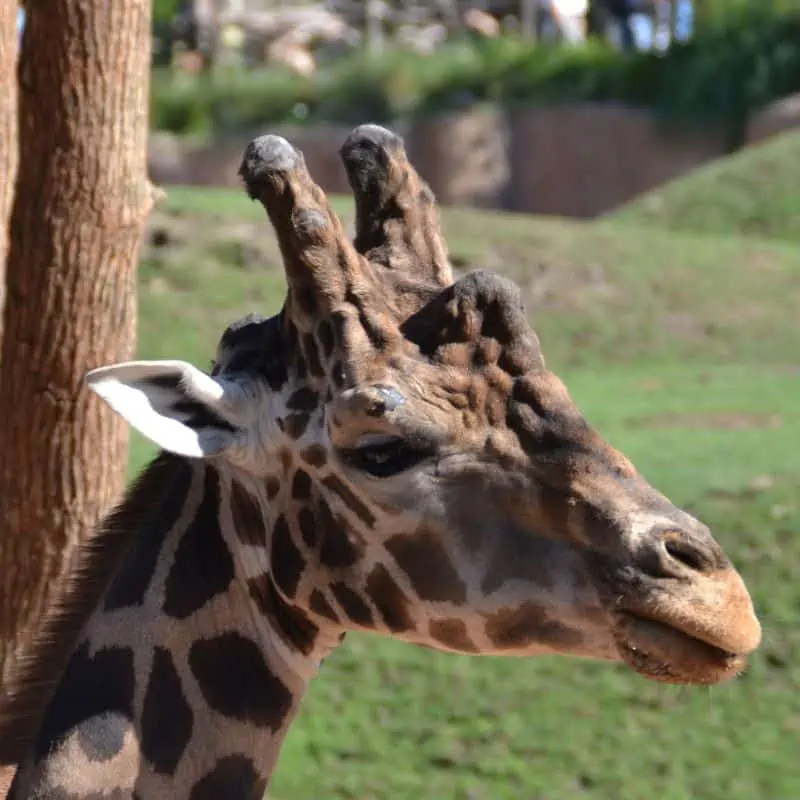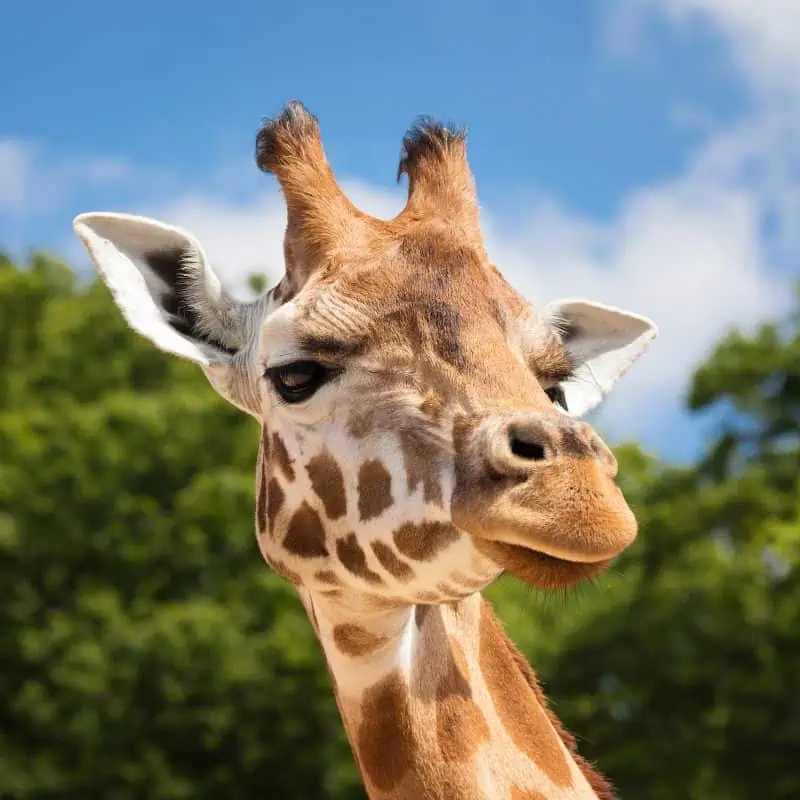Looking at the top of a giraffe’s head, you wouldn’t be too far off thinking that they have a pair of horns hidden beneath their hair. Do giraffes have horns, though?
No, giraffes do not have horns; they have ossicones. Ossicones are bone structures covered by the giraffe’s skin and fur. Giraffes are distant relatives of the sivatherium. An extinct animal with what looked like antlers but were, in fact, ossicones.
In this article, let’s take a closer look at the ossicones of a giraffe, one of their most unique features.

Do giraffes have horns or ossicones?
As mentioned, giraffes do not have horns; instead, they have ossicones.
These ossicones are a feature that is unique to the giraffe family, and they are different from horns because they are made out of bone.
What are ossicones?
An ossicone is a feature on a giraffe that looks like a horn, but it is not. These are bone structures that are different from horns and antlers because they are a part of the skeletal system and they are always covered by skin or fur.
Giraffes have three ossicones on their foreheads. There are two near the back of their head, and a third one is just above their eyes.
For most giraffes, this third ossicone is relatively small, but it’s between three and five inches long on bull Northern giraffes.
One subspecies of giraffes have five ossicones, the two obvious ones and three more that are a little harder to spot. This is the Rothschild’s giraffe (an ecotype of the Nubian giraffe subspecies).

What are ossicones used for?
Modern giraffes use their ossicones to defend themselves against other animals, but primarily for fighting with other giraffes.
They do this by swinging their head quickly at their opponent to use the ossicones to knock their opponent down.
Giraffes are usually docile creatures, but they can be territorial and aggressive if they feel threatened or when fighting over a mate.
There is another theory on the biological role that the ossicones might play, but this has not been proven. There are many nerve endings and blood vessels in the ossicones. This has led some scientists to believe that the ossicones may play a role in how giraffes maintain homeostasis and heat regulation. Again, this has not been confirmed though.
What are ossicones made of?
In the simplest terms, ossicones are made of bone covered in skin. When a giraffe is born, the ossicones are not attached to their skulls yet. This happens as the giraffe starts to grow, thanks to the cartilage on its skull.
This is an evolutionary safety measure that is designed to protect both the mother and the baby giraffe.
Giving birth to a child with ossicones sticking out of their head would be dangerous to both the mother and the child.
Male and female giraffes usually have different ossicones. Male giraffes generally have ossicones that are thicker and become bald quickly.
This is because the giraffe will wear the fur off of the top of its head by brushing it against leaves while they are eating fruit. In comparison, female giraffes have similar ossicones, but theirs are smaller than the ones of a male giraffe.

Where does the name come from?
Ossicone is a strange word that you probably have not heard before. The name comes from ancient Latin and middle French vocabulary.
The Latin word os means bone, combined with the French word cone, meaning cone. This created the word ossicone.
This means that the literal translation of the word ossicone is “bone cone.”
Do other animals have ossicones?
There are a few other animal species that have ossicones, but they are mostly all extinct. These species are:
- Sivatherium
- Climacoceratids
- Climacoceras
- The Okapi
Of these four species, the Okapi is the only one still alive. The rest of these are all extinct ancestors of the modern giraffe family.
The Okapi is a unique species that can only be found in certain parts of the Dominican Republic of the Congo. You could say they look like a hybrid of a giraffe, a zebra, and maybe an antelope. They are also sometimes called the forest giraffe, and they live in the Congo’s deep rainforests.
The ossicones on an Okapi are usually smaller than a giraffe’s but also significantly sharper, whereas giraffes are typically blunt.
Unlike female giraffes, female Okapis do not have ossicones on their heads. This makes them easily stand out from their male counterparts.
Scientists believe that the sivatherium might have looked like a cross between a giraffe and an okapi, but with more prominent horns than either.
Theory suggests that giraffes descended from these creatures, but the horns did not disappear during the evolutionary process. They only grew smaller.
Giraffes also bear a resemblance to the Climacoceratids. These creatures looked a little bit more like giraffes than the sivatherium did. Some biologists have studied Climacoceratids’ old bones and believe they are closer relatives of modern giraffes.
Final thoughts on giraffe horns
There you have it; giraffes have ossicones on their heads, not horns.
These ossicones usually are made up of two prominent ones, with one less visible one, although in some rare giraffe subspecies, you can find up to five ossicones on their head if you look closely enough.
While the exact purpose of these hornlike features is not known, giraffes have been seen using them when they fight other giraffes.
